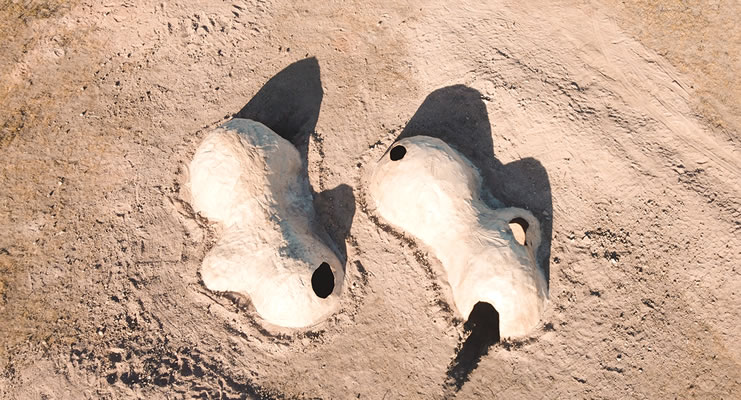From the air they looked almost like giant peanuts, but in reality the two experimental structures on a local ranch this summer were the handiwork of a team from Texas Tech University’s College of Architecture.
The Agg Hab, or Aggregate Habitat, is a prototypal eco-dwelling formed by casting Papier-mâché strips into sculpted holes in the ground, according to Brendan Sullivan Shea, one of the team members.
Shea said the Oakes Creek Residency program offered by Donley County rancher Jack Craft was the perfect fit for his team to try out their unique construction method.

“We rented an excavator there in town, dug two holes, and used those as the forms,” Shea said.
The holes mirrored each other’s shape, and the team lined the floor and walls with a Papier-mâché made of dirt, glue, and recycled paper, Shea said.
“Once it dries, it delaminates from the ground,” Shea said. “Then to lift it out and flip it was difficult so we didn’t tear it.”
The Panhandle wind then became both a blessing and a curse, he said, as it made it easier for the team to lift the structure out of the whole, but also made it difficult to handle before rebar could be staked around the edges to hold the forms in place. Once finished the form lifted from one hole made the perfect roof for the other hole and vice versa.
“The bottom was tough, but the top was light and mirrored the bottom,” Shea said. “Because of the construction, the structure breathed a lot.”
At 20 feet long, eight feet wide, and four and half feet tall, Shea said the structures were unofficially the largest Papier-mâché structures in the world for the short time of their existence.
“We didn’t realize that at the time; we didn’t check Guinness until later,” he said.
Shea said his team is comprised of visiting professors at Texas Tech who are experimenting with new ideas in space and form. They gained a great deal of knowledge from the Oakes Creek project and said the Clarendon area provided a great opportunity and inspiration.
“I don’t think we’ll be building houses this way, but we’ve learned a lot,” he said. “The paper is self-supporting and the geometry carries the weight. In the future you could design cities this way using concrete instead of Papier-mâché. It’s an ecologically friendly footprint.”
Rain and hail made the project short-lived, however, as one Panhandle storm collapsed the structure. Team members pushed the dirt back in the holes to ultimately leave no trace they had ever existed.
“It took two weeks to build, had two weeks of life, and was gone in two hours of destruction,” Shea joked.


Leave a Reply
You must be logged in to post a comment.